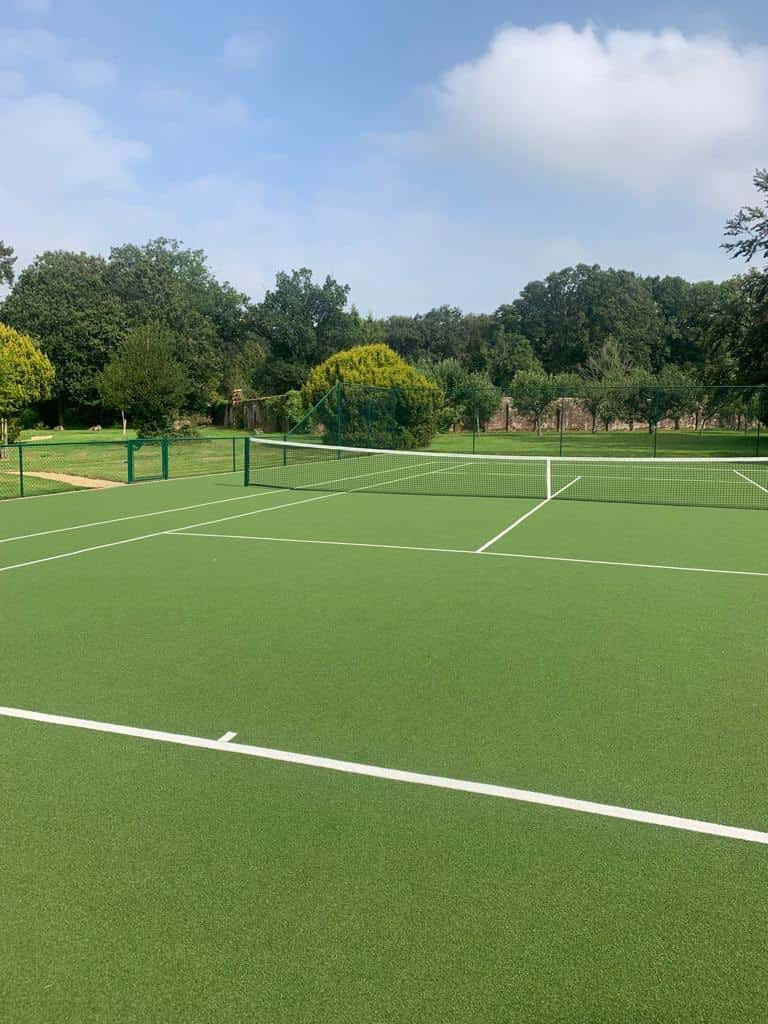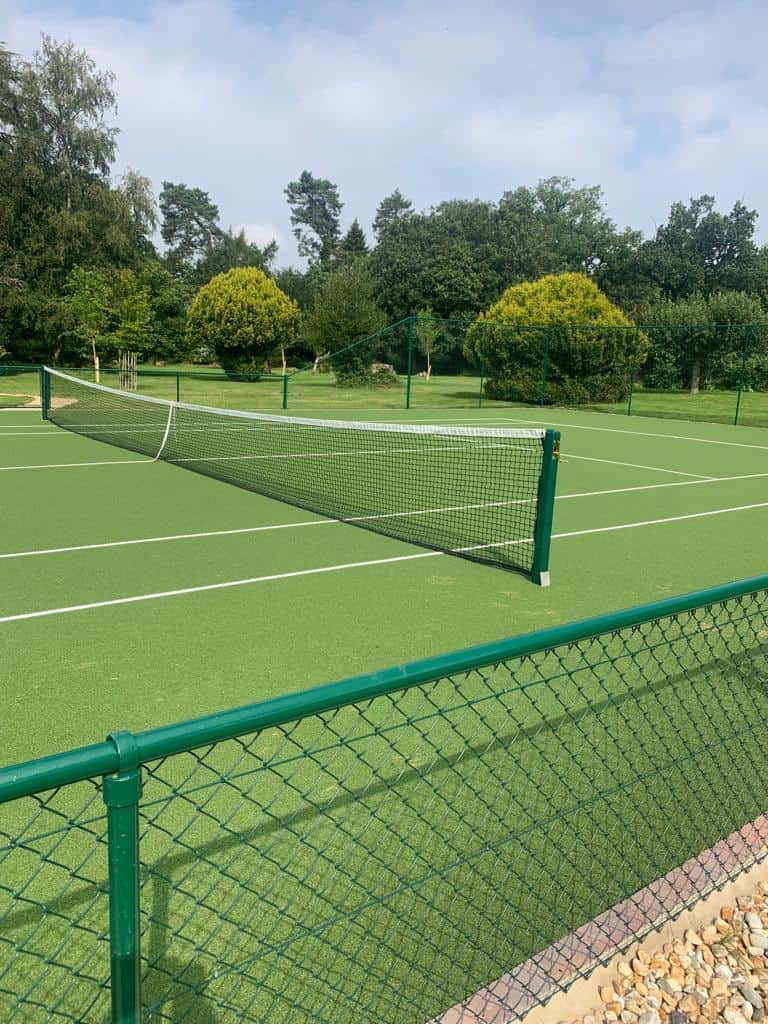Tennis courts are a great addition to any property, providing a space for exercise, recreation, and leisure. However, over time, the wear and tear from frequent use, weather conditions, and aging materials can lead to deterioration. When your tennis court starts showing signs of damage, you may find yourself asking whether resurfacing or a full rebuild is the better option.
At Tennis Court Construction Essex, we specialise in both resurfacing and rebuilding tennis courts throughout Essex, providing professional advice and services to ensure your court is in optimal condition. In this blog post, we’ll help you determine whether resurfacing or a full rebuild is the best solution for your tennis court.
1. What Is Tennis Court Resurfacing?
Tennis court resurfacing is the process of restoring the surface of your existing court by adding a fresh layer of material. This involves repairing cracks, smoothing out uneven areas, and reapplying the surface material, whether it’s tarmac, synthetic, or acrylic. Resurfacing is ideal for courts that are structurally sound but have become worn down over time.
Why it’s important:
- Cost-effective: Resurfacing is generally less expensive than a full rebuild since it involves working with the existing structure.
- Minimal disruption: The process is quicker and requires less disruption to your property compared to a full rebuild.
2. What Is a Full Tennis Court Rebuild?
A full rebuild involves removing the old surface and potentially the base layers beneath it to replace them entirely. This may be necessary if the court has suffered severe damage, such as foundation problems, drainage issues, or structural instability. A full rebuild is a more comprehensive solution, and while it is a larger investment, it ensures that your tennis court is in excellent condition for many years.
Why it’s important:
- Long-term solution: A complete rebuild is ideal for courts that have significant underlying issues or those that are reaching the end of their useful lifespan.
- Improved performance: A full rebuild allows for the opportunity to improve the overall performance and aesthetics of your court with a more durable surface and updated materials.
3. Signs Your Court Needs Resurfacing
If your court shows only minor wear, cracks, or cosmetic issues, resurfacing might be the ideal solution. Here are a few signs that resurfacing is a good option:
- Cracks or surface imperfections: Small cracks, minor divots, or rough areas can often be repaired and smoothed out with resurfacing.
- Worn-out surface but good foundation: If the court’s base and drainage system are still in good condition, resurfacing can extend the life of your court without the need for a full rebuild.
- Aesthetic concerns: If the surface is discoloured or faded but the structural integrity is intact, resurfacing can restore the court’s appearance and improve playability.
Why it’s important:
- Cost-effective maintenance: Resurfacing provides a fresh, functional surface at a lower cost than a complete rebuild, making it a cost-effective way to restore your court’s performance.
- Increased playability: Resurfacing helps to smooth out imperfections, allowing for better playability and a safer surface for players.
4. Signs Your Court Needs a Full Rebuild
In some cases, resurfacing alone won’t address underlying issues. If your tennis court has significant structural damage, a full rebuild may be necessary. Here are some signs that indicate a full rebuild is the right solution:
- Large or deep cracks: Cracks that go beyond the surface or have compromised the foundation may not be repairable with resurfacing.
- Poor drainage: If your court has drainage problems that lead to pooling water or flooding, this can affect the court’s integrity. A full rebuild allows you to address drainage issues at the foundation level.
- Uneven surface: If the base layer is uneven or the court has sunk in certain areas, a rebuild will be required to level the foundation before applying a new surface.
- Foundation or structural issues: If the foundation of your court is compromised—due to soil erosion, movement, or long-term wear—a rebuild will address these issues and ensure long-term stability.
Why it’s important:
- Preventing future issues: A full rebuild addresses both surface and structural issues, ensuring that the court will be durable and stable for many years.
- Value for money: While more expensive upfront, a full rebuild can be a more cost-effective long-term solution, especially if the court has serious foundational or drainage issues.
5. How to Choose Between Resurfacing and a Full Rebuild
Choosing between resurfacing and a full rebuild depends on several factors, including the severity of the damage, your budget, and how long you want the court to last. Here are some key considerations:
- Condition of the foundation: If the foundation is still strong and the issues are primarily surface-level, resurfacing is a good option.
- Budget: Resurfacing is a more affordable option for those looking to make minor repairs without a significant investment. However, if your court has extensive damage, a rebuild might be a better long-term investment.
- Usage: If the court is used frequently or for professional play, a full rebuild might be necessary to ensure the court performs at its best.
Why it’s important:
- Informed decision-making: Understanding the extent of damage and your specific needs will help you make the best choice between resurfacing and rebuilding.
- Professional advice: A qualified contractor, like Tennis Court Construction Essex, can assess the condition of your court and recommend the best solution.
Conclusion
When deciding between resurfacing and a full rebuild, it’s essential to assess the condition of your tennis court and determine what will provide the best long-term value. Resurfacing is an excellent option for minor repairs and cosmetic improvements, while a full rebuild is necessary when there are significant structural or foundational issues. At Tennis Court Construction Essex, we specialise in both resurfacing and rebuilding tennis courts in Essex. Our expert team will assess your court’s condition and provide tailored solutions to ensure your court is in optimal condition.
If you’re unsure whether resurfacing or a full rebuild is the best option for your tennis court, contact us today for a professional evaluation. We can help you make an informed decision and ensure your court remains in top shape for years to come.
Call us on: 01245 945 895
Click here to find out more about Tennis Court Construction Essex
Click here to complete our contact form and see how we can help with your tennis court.


